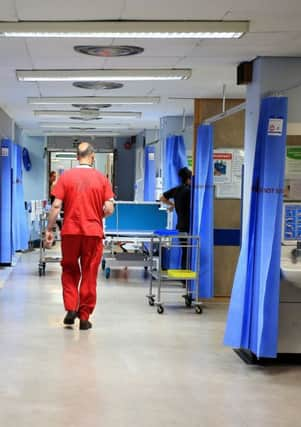Scotland even further behind key NHS target


The Scottish Government aims for 95 per cent A&E patients to be seen and either admitted, transferred, or discharged within four hours. But health boards are currently averaging a performance of just 93.97 per cent in 2017.
The rate is lower than both the 94.05 per cent recorded for all of 2016, and the same eight-month period last year, when it stood at 94.21 per cent.
Advertisement
Hide AdAdvertisement
Hide AdOver the course of nearly five years, meanwhile, Scotland’s biggest health board has met the 95 per cent target just once.
It comes as figures compiled by the BBC show nearly five years have passed since the NHS in Scotland treated at least 95 per cent of cancer patients within 62 days of receiving an urgent referral, with the health service also underperforming when it comes to planned operations.
With more people presenting at A&E in winter, the rate is expected drop even further. The 95 per cent target was met for three successive months between June and August, but June was the first time it had been achieved in 11 months.
Alex Cole-Hamilton, health spokesman for the Scottish Liberal Democrats, said: “These horrendous and embarrassing waiting times are not the fault of hardworking emergency medics and staff, but the fact we don’t have social care packages for people leaving hospital.
“People are more likely to attend A&E in winter and we just can’t wait for this crisis to hit, we need to act and built in social care provisions to ensure there’s an uninterrupted flow throughout the NHS.”
Colin Smyth, Scottish Labour’s public health spokesman, said: “These are deeply troubling figures that show urgent action is needed from the SNP if we are to avoid a treatment crisis this winter. Meeting targets occasionally during the summer months is not enough.”
Official figures also show that since October 2012, NHS Greater Glasgow and Clyde fulfilled the 95 per cent target just once, in July 2015.
Dr David Stewart, the health board’s deputy medical director, said it had fewer alternatives to hospital admission than comparable boards, but was developing a “wider range of options” to prioritise beds for those with the greatest medical need and help people stay in their own homes.
Advertisement
Hide AdAdvertisement
Hide AdMatt McLaughlin, head of health at Unison Scotland, said: “Continued underfunding, the pressure to make cuts, and short staffing have resulted in the circumstances which lead to these statistics.
“We are extremely concerned that the upcoming winter season will place even further pressure on NHS services and the minor investment from the Scottish Government is not going to deal with the levels of short staffing.”
Jill Vickermann, national director of BMA Scotland, said NHS capacity was “not keeping up” with patient needs and warned against “heaping greater pressure” on overstretched staff to meet targets.
A spokesman the Scottish Government said: “Scotland’s core accident and emergency departments have outperformed those in the rest of the UK for almost two and a half years. We are committed to improving unscheduled care and have invested an additional £9m in the NHS each year over the last three years.
“This has supported the appointment of dedicated national and local teams to focus on improving patient flow, ensuring that once people arrive into A&E, they can be admitted or transferred in a timely way.”